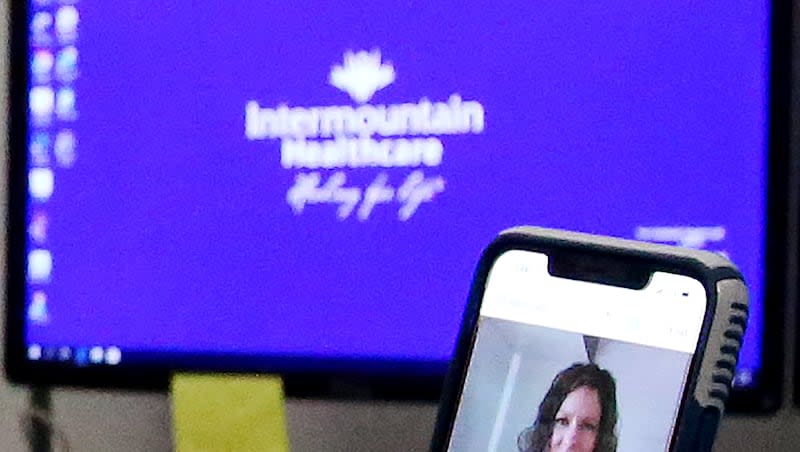Rep. Blake Moore wants more Americans to be able to access health care from home

- Oops!Something went wrong.Please try again later.
Rep. Blake Moore has four boys under 12. His wife, Jane, is “very busy, especially with me being gone so much,” he said at a Ways and Means Committee hearing Tuesday morning.
The committee was tackling “enhancing access to care at home in rural and underserved communities,” an issue personal to Moore, the vice chair of the House Republican Conference. “Finding telehealth opportunities for ailments or conditions that could be solved” at home would give his family more flexibility, he said.
And he believes he wouldn’t be the only one to reap the benefits. In Utah, Intermountain Health has several telehealth programs, like acute care, hospital-level care at home and remote patient monitoring, that emerged in response to changes required during the COVID-19 pandemic, according to testimony given at the hearing.
The Ways and Means Committee invited Dr. Nathan Starr, a medical doctor and the lead of the tele-hospitalist program at Intermountain Health, headquartered in Salt Lake City, to testify about the policies necessary to support current and future at-home care.
Moore, who represents Utah’s 1st District, said he appreciates the desire to reduce red tape and offer more affordable options in health care. “Utah has all the right answers in most cases,” Moore said in an interview with the Deseret News, accompanied by Starr.
How can telehealth save money for patients?
At the hearing, Starr said the response he and his teams have received from patients “has been really positive” and said because of the increased accessibility, patients are encouraged to keep up with their medical care.
So far, Intermountain Health has reported zero in-home safety events, saved 4,000 bed days and received a Press Ganey Patient Satisfaction score of 85%, according to Starr’s written testimony.
Starr said using the program also saves patients money. “Our telehealth program runs in the red significantly if (we) just look at net operating income,” he said. But, he said, his hospital system believes it creates value for their patients.
Care recipients can economize on gas money and child care costs as well as time away from family and work, Starr said. They also save in hospital fees related to “transferring the patient from one location to another and unnecessary interventions,” whether it’s imaging or procedures that can be avoided because of the large pool of on-deck experts.
In his written testimony, Starr cited an example of chemotherapy patients receiving treatment through video visits from oncologists, allowing them to “stay in their communities with family and friends.”
“Typically, in-person infusion times can last up to 12 hours, and if a patient needs to drive hours to get to infusion, each treatment could be a multi-day trip,” Starr said. “For 849 patients receiving Tele-Oncology services in Richfield, Utah, the total drive time saved was 232,626 minutes.”
Of course, guardrails should also be in place. “We can’t take it too far, where we’re performing surgery over Zoom,” Moore said.
How can telehealth unburden health care workers?
“The other side of the coin is the workforce shortages,” especially in rural and underserved areas, the Utah representative said.
In his interview with Deseret News, Starr said offloading work from areas experiencing staffing shortages, and accommodating them into the telehealth program, can “provide assistance from a central location efficiently.”
It also “allows the providers in those rural areas to sleep at night knowing that patients are being cared for and they’re not getting woken up by nurses with questions,” he added.
The remote monitoring program allows a medical practitioner to see more patients, said Starr, noting the high involvement of nurses, who support physicians and patients. This results in higher job satisfaction reported by health care and frontline workers in remote areas, he said.
But the top limitation of telehealth is the lack of face-to-face contact. “Sometimes being able to see a patient in person, press on their belly yourself, is so reassuring and helpful,” said Starr. Virtual visits are often “a little tighter,” with less time for chitchat.
What can Congress do to expand telehealth?
At the hearing, Starr urged Congress to pass the Expanding Care in the Home Act, introduced in the Ways and Means Committee last year. This legislation would make at-home care a viable option for more patients. Starr also urged lawmakers to extend the pandemic-era Acute Hospital Care at Home Initiative by five more years.
He told the Deseret News he sees an urgency to pass this bill and the extension. Should Congress fail to pass an extension, it would force many hospitals to drop telehealth programs, which could call for “reinvestments, reeducation and retraining” while patients find limits on their options.
If hospitals are forced to put telehealth programs on pause, health care providers would have less confidence and stability to keep operating, Moore said, adding, “So, let’s continue making sure they have an environment that is predictable.”
Moore said he sees strong bipartisan support behind remote health care and he’s hopeful these pieces of legislation pass. But “Congress sometimes likes to screw up the two car parade, if you will,” he said jokingly. “This is a simple reauthorization. Let’s not let Congress and all the drama get in the way.”
“What I mean by that is when there’s something popular, things get tacked on to it, or you get leveraged in one way or another,” Moore said. “We’ll do our best to try to avoid that.”
This story has been updated.

